1965 Jet BoardEngineEngine Dismantling |
Engine - Dismantling
Unfortunately, I found an engine rebuild manual on the Jet Board engine after I had already rebuilt the engine. The specifications noted are what I can work out from taking the engine apart and some specs from the manual. Above is a shot of the engine as it looked before we cleaned it and started taking it apart. Here's what we know:
Above is an exploded overview of the engine during the disassembly. The barrel is a very strange casting because the head is not removable. The entire barrel and head is a single casting, cast around a steel liner inserted for the bore surface. The crankcase splits into four parts, with the main bearings supported by the pull start flange on one side, and the jet drive flange on the other. The carb intake is directly across from the barrel - you can just see the mounting bolts in my brother's hand above.
Someone had a good go at filling every gasket face with blue goo. We decided that we'd just make new gaskets and do it properly. Click here for a PDF of the gaskets at full scale. Above is a shot of the head cover being removed. Years of seawater had left all kinds of gook inside the head water cooling jacket.
The piston is another oddity for me although I have a lot of experience with 2-stroke motors. I have seen domed pistons like this one, deflector type pistons like this one, but never a completely flat head piston like the one in the Jet Board. It has two typical piston rings and it doesn't use a small end bearing at the gudgeon pin (just a bushing). Also it does not have any piston ring pins so it looks like the piston rings can rotate freely.
Above is a quick shot of the main crankcase transfers. They go outside the steel barrel liner, and into barrel transfers. The outside of the barrel transfer has a removable access panel with a gasket face. Next Section -->
|
|||||||||||




